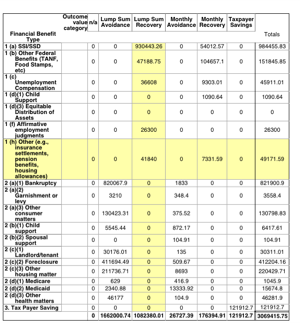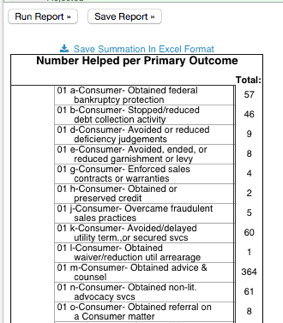LegalServer
- Outcomes V2 is a sophisticated tool within LegalServer that allows agencies to collect one or more outcomes achieved within a case. Outcomes can be captured in "groupings" (typically needed for specific funder reporting) such as IOLA Primary, Secondary, Tertiary and/or Tax Payer Savings, etc. For ease of use, agencies can limit the outcome choices (that an end-user sees) based on a funder's specific requirements as well as by legal problem code.
Additionally, each outcome can have one or more (predesignated) Financial Benefit(s) associated with that Outcome (such as Lump Sum Recovery, Monthly Recovery, etc). Each outcome is tracked by date achieved to make it easier to track outcomes throughout the case.

These articles explain Outcomes V2 in more detail:
- http://help.legalserver.org/home/site-admins/outcomes-v2-for-admins
- http://help.legalserver.org/home/cases-matters/outcomes-v2
- Outcomes reporting. Once recorded, outcomes can be reported via LegalServer's standard reports engine. Outcomes are typically reported:
-
- Grouped by outcome categories and in summation (counting the number of outcomes recorded for a period of time)
- Grouped by financial benefit reporting category and financial benefit type, including subtotals and grand totals


- Additional information collected that are relevant to outcomes/financial benefit. In addition to collecting outcome information, agencies also typically collect the following information:
-
- Number of people helped—sometimes divided between people under 18 and people older than 18
- Highest level of service
- Legal problem code
- Special legal problem code
- Legal issues in the case
- Advocacy issues in the case
- Level of service block. The level of service block in LegalServer allows agencies to track the level of service throughout the life of the case (as opposed to simply recording it as a closing code at the end of the case). This is helpful for a number of reasons, but perhaps most importantly it helps managers determine the caseload of each caseworker, as well as set appropriate goals (desired outcomes—see below). Level of service is also a good indicator for evaluating the outcomes of each case to see what outcomes are appropriate given the level of service of the case—for example, we would not expect an outcome for a brief service case to be saved home from foreclosure, but we might expect an outcome to be informed homeowner of due process rights. More information about level of service can be found here: http://help.legalserver.org/home/cases-matters/level-of-service.
- Case goal tracking. What does success in this case look like? (i.e., what are we hoping to achieve by taking this case?) Goals are "desired outcomes" in LegalServer. This tool was designed as a complement to the Outcomes V2 tool. It allows agencies to indicate what the desired outcome of the case will be, then measure as to how well they did in achieving that goal (e.g., achieved goal, partially achieved goal, did not achieve goal, etc.). For example, the goals in a foreclosure case may be: (1) to place the client with relatives, (2) to avoid homelessness, and (3) to stay in the home longer. Thus, when the house is foreclosed (because the client could not afford the mortgage—not a legal problem), the outcome of the case in the case is measured as to how well we did in obtaining our desired goals and not recording an outcome of home foreclosed. More information about goals can be found here: http://help.legalserver.org/home/site-admins/blocks/set-desired-matter-outcomes-goals.
- SMS/text messaging. Finally, the new SMS/text messaging feature recently developed in LegalServer will likely be used by agencies to allow clients to update their outcomes periodically in a case. This feature is still being developed, but is a good way of thinking out how agencies will—in the near future—collect outcome information from clients after their case has ended. Simply schedule a text message to be sent with a URL for the client to complete a quick survey/update their case outcomes.
